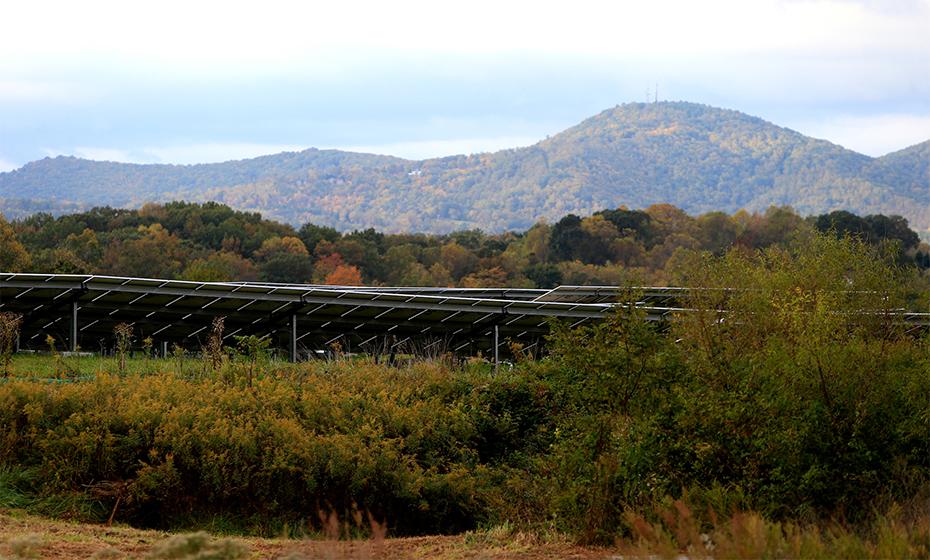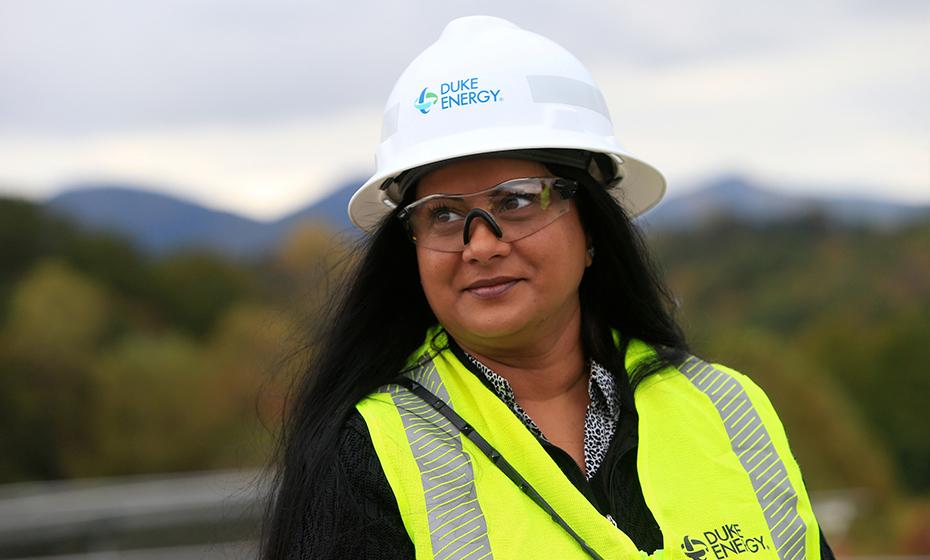From Waste to Watts: Landfill Finds New Life as a Solar Plant
Duke Energy teams up with Buncombe County, N.C., to serve more customers with renewable energy
By Gina DiPietro | illumination Staff Writer
In the rolling hills of Asheville, N.C., a transformation is underway. As the community announced a goal to power all of Buncombe County with 100% renewable energy by 2042, Duke Energy set out to construct another solar facility as part of the Western Carolinas Modernization Plan.
The challenge? To find enough space – 20 to 30 acres – to build a 5-megawatt (MW) solar plant in a region with smaller parcel sizes, mountainous terrain and a high cost of buildable land.
Larry Watson, a business developer at Duke Energy who originated the project, saw an opportunity to collaborate with Buncombe County, which wanted to find a way to repurpose a solid waste facility near Interstate 26 and the French Broad River.
The answer: Duke Energy’s first solar plant on a municipal landfill.
“It presented some challenges,” Watson said, “like constructing a solar facility without penetrating the cap, the landfill’s surface. But it also offered new acreage in the North Carolina mountains where open space and flat land is hard to find.”
To offset the higher cost to build Woodfin Solar Facility, Watson’s team drew up an equally creative lease agreement where Buncombe County is compensated in renewable energy certificates (RECs) rather than cash.
One REC is issued when 1 MW-hour of electricity is generated and delivered to the grid from a renewable energy source. They can be bought, sold or traded to organizations or individuals who want to offset their carbon footprint and support clean energy.
It’s a creative regulatory solution that moves both parties forward, said Jennifer Bennett, Duke Energy’s government and community relations manager in the Asheville region.
“It just adds to the uniqueness of this project,” Bennett said. “And I think it’s worth highlighting that it’s taken a lot of people thinking creatively and working incredibly hard to pull this off.”
As owner and operator of the 5-MW facility, Duke Energy will generate enough solar energy to power about 1,000 customers annually, while furthering the county’s renewable energy goals by about 20%.
“Meeting our ambitious goal requires creative thinking and collaboration,” said Buncombe County Sustainability Director Jeremiah LeRoy. “This project is a terrific example of both as it will supply our community with renewable energy for decades to come.”
Also tangible, said Duke Energy Project Manager Nisha Strain, was the opportunity to bring renewed purpose to a site that couldn’t be used for anything else.
“Solar is land-intensive, so the adaptive reuse of this property is key,” Strain said. “It required a lot of creativity in how we’d construct it on an uneven surface, but it also shows the company’s effort to repurpose existing infrastructure as we transition to a zero-carbon future.”
Her role included regular site visits to Woodfin, N.C., where crews constructed a system that’s similar to what you’d see on a rooftop. Concrete ballast blocks, gravel and adjustable racking were brought in to level out the surface, creating a steady foundation for solar panels that suspend above the landfill so as not to penetrate its cap.
“We also needed to keep the cable trays above ground,” Strain said of equipment that carries solar power to the grid to serve customers, “while creating access points for maintenance and vegetation management.”
While the landfill’s been closed since 1996, municipal employees need access to perform state-required monitoring activities. The county retains this responsibility under the 25-year lease agreement, with options for renewal. They also take ownership of any subsurface risks, including waste buried below the surface.
“We are encouraged to see this project come to fruition,” said Dane Pederson, Buncombe County solid waste director. “It’s both a productive use of the closed landfill space and an innovative solution for integrating solar panel systems while protecting the existing cap layer over the landfill, with no surface penetrations.”
Woodfin Solar Facility is backed up by the 560-MW Asheville Combined Cycle Station, a cleaner-burning natural gas plant that is 75% more efficient than the coal plant it replaced (previously at the same site). The grid needs dispatchable resources like natural gas, which can generate electricity in any type of weather, to support greater integration of renewables (like solar, available only when the sun is shining) to maintain reliability for customers.
While this infrastructure is geographically in the Asheville region, energy is fed to the grid to benefit communities in both North Carolina and South Carolina.
Duke Energy believes solar, and energy storage, will play an important role in how more diverse, clean energy is delivered to Carolinas customers. North Carolina is already fourth in the nation for solar and the company is targeting to have more than 6,400 MW of new solar on the system by 2031. The company is also targeting solar procurement in the Carolinas of over 1 gigawatt annually later this decade.
Woodfin also delivers on Duke Energy’s commitment to deploy 15 MW of solar and at least 5 MW of battery storage as part of the Western Carolinas Modernization Plan, which aims to meet the region’s growing power needs with safe, reliable and affordable energy. And at each step of the process, public input laid the foundation for what came next.
“From letters of support,” Bennett said, “to advocating for the construction of projects, the Asheville region was active in bringing this plan to life. And that kind of grassroots community advocacy still remains for Duke Energy's infrastructure investments in the region.”
View original content here.






